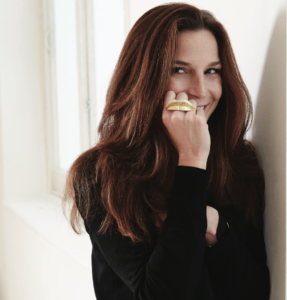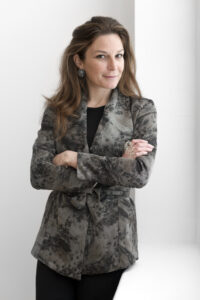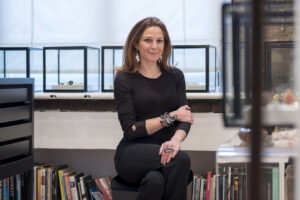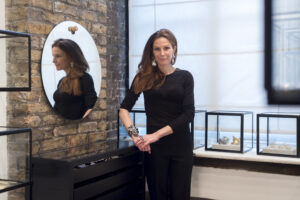Episode 155
What you’ll learn in this episode:
- The difference between art jewelry and jewelry by artists
- Why more collectors and jewelry enthusiasts are starting to appreciate artist jewelry
- How Elisabetta helps visual artists bring their first pieces of jewelry to life
- Why artist jewelry is a smart investment
About Elisabetta Cipriani
Elisabetta Cipriani invites world leading contemporary artists to create aesthetically innovative and socially relevant wearable art projects. Since the opening of her namesake gallery in 2009, Elisabetta’s pioneering vision has redefined the boundaries between jewelry and fine art, capturing the imaginations of artists and collectors across the globe.
The gallery has collaborated with over 50 critically acclaimed painters and sculptors, including Ai Weiwei, Chiharu Shiota, Giulio Paolini, Ilya & Emilia Kabakov, Carlos Cruz-Diez, Enrico Castellani, Erwin Wurm, Giorgio Vigna, Jannis Kounellis, Rebecca Horn, and Pedro Cabrita Reis, to name a few.
The gallery’s projects can be found in museums and private collections across the globe, including Musée des Arts Décoratifs, Paris; Museum of Art and Design, New York; World Jewelry Museum, Seoul; and The State Hermitage Museum, St Petersburg. A number of Elisabetta Cipriani’s jewelry collaborations are featured in From Picasso to Koons: The Artist as Jeweler, the international touring exhibition of artist jewelry curated by Diane Venet.
Elisabetta Cipriani participates in leading art and design fairs, including Design Miami and Design Basel, TEFAF Maastricht, Artissima Turin, MiArt Milan, PAD London, and PAD Monaco.
Additional Resources:
Photos:




Transcript:
For a long time, jewelry created by visual artists was considered lesser than artwork made in the medium the artist was known for (compare the price of Man Ray jewelry to the price of Man Ray photographs, for example). But in recent years, both jewelry and art collectors have realized the significance of artist jewelry, due in no small part to Elisabetta Cipriani. Through her gallery, Elisabetta Cipriani Wearable Art, Elisabetta collaborates with leading visual artists to create limited edition artist-made jewels. She joined the Jewelry Journey Podcast to talk about what inspired her to combine fine art and jewelry; the process she uses to work with artists; and why jewels by artists should be a part of any jewelry lover’s collection. Read the episode transcript here.
Sharon: Hello, everyone. Welcome to the Jewelry Journey Podcast. Here at the Jewelry Journey, we’re about all things jewelry. With that in mind, I wanted to let you know about an upcoming jewelry conference, which is “Beyond Boundaries: Jewelry of the Americas.” It’s sponsored by the Association for the Study of Jewelry and Related Arts, or, as it’s otherwise known, ASJRA. The conference takes place virtually on Saturday and Sunday May 21 and May 22, which is around the corner. For details on the program and the speakers, go to www.jewelryconference.com. Non-members are welcome. I have to say that I attended this conference in person for several years, and it’s one of my favorite conferences. It’s a real treat to be able to sit in your pajamas or in comfies in your living room and listen to some extraordinary speakers. So, check it out. Register at www.jewelryconference.com. See you there.
This is a two-part Jewelry Journey podcast. Please make sure you subscribe so you can hear part two as soon as it comes out later this week. Today, my guest is Elisabetta Cipriani, founder and owner of the gallery Elisabetta Cipriani Wearable Art, a gallery of limited-edition jewels created by artists. The gallery has collaborated with more than 50 well-known painters and sculptors since its opening in 2009. We’ll hear more about Elisabetta’s jewelry journey today. Elisabetta, welcome to the program.
Elisabetta: Hello, Sharon. Thank you for having me.
Sharon: So glad to have you. Tell us about your jewelry journey. Did you study jewelry as a young girl? Did you like glittery things? Tell us about that.
Elisabetta: Basically, I didn’t study jewelry when I was in university. I never studied jewelry; I only had a big passion for traditional jewelry. I’m Italian. I come from Rome, and there is this Italian tradition of having beautiful jewelry. Especially in the 80s, women were going out with parures, with the necklaces and bracelets. They were taken out from the safe for special occasions. I have memories of me as a young girl on my mother’s bed with her jewelry on the bed, dressing up for various events and weddings. I was touching them and looking at them from the back and the front, and I was trying them on and asking her all the time, “Please, can I have this when I’m older?” I was playing with them while she was selecting the right piece for the right event. For me, when she went out, it was the best moment. It wasn’t like playing with a doll. It was like, “Oh my god, beautiful jewelry. I can have a look at them again.” I’ve always had this passion.
I have a background in jewelry in terms of how to make a jewel. I didn’t study the history of jewelry. Of course, now I know about it because I read and studied a little bit. I’m not an expert; I know what I’m talking about, but I never had the occasion to study in depth in university, for example. When I finished school, I wanted to study jewelry, to create jewelry, and my father said, “There’s no way you can do that. You need to do a proper degree.” I took a gap year, and I remember that I did an evening course on pearls and diamonds. It was really advanced, and I didn’t understand much of it, but I ended up doing history of arts, which is now all connected.
After university, I worked in a museum of contemporary art in Rome called MACRO. It’s a state museum for contemporary art in Rome. I worked there for three years as co-curator. I had the best experience of my life because I met the most important artists the museum was inviting to have their exhibitions there. How old was I? I was 23 years old, and for me, it was natural to talk to a famous visual artist like Tom Wesselmann, who passed away, or Cecily Brown, Vik Muniz, Tony Cragg. For me, it was natural to have a conversation with them and go to their artists’ studio with the director of the museum to select the artworks for the exhibition. I learned how to move in the world of art with the artists. I was really comfortable being with them, but deep in my heart, I always had this love for jewelry. I was wearing jewelry from my mother and grandmother that they were giving to me as gifts. I always kept it as a passion.
I moved to London in 2005, and I worked for an art gallery. I left Rome because I wanted to grow and be independent and learn the art market, how you sell an art piece, rather than being a curator. Then I learned about jewelry by Picasso and Man Ray, and I thought it was an interesting topic to follow and learn about. Then there was Louisa Guinness. I used to work for the husband of Louisa Guinness, Ben Brown. At that time, I think it was two years since she had started her business, and she had one kid after another. She asked me to bring the cabinet of jewelry to the art fairs, so I was bringing this cabinet with Picasso jewelry and Kapoor jewelry. It was 17 years ago. I remember there was an interest in artist jewelry, but not as much as today. I was selling the pieces. People were seeing them more as jewelry back then, sculptures by artists. It’s weird how things have changed. The perception is that what you are buying or owning is not a jewel, but it’s an art piece you can wear by a visual artist.
I worked for Ben Brown for three years, and then I got married. When I was pregnant, I said, “That’s it. I’m not going to continue working for the gallery. I want to work independently. I’m going to open my own business.” I started an artist jewelry gallery. I invited the artists I met at the Museum of Contemporary Art in Rome and asked them to work with me. At the beginning, they were very supportive. Most of them said yes. One didn’t say yes, but I’m still in touch and asking him if he would like to do a project with me. I’ve been waiting 12 years and he hasn’t come back to me yet. He didn’t say no. They say they are busy with their art works, with their museum shows. An artist needs to be free mentally and needs the time to sit down and work small. You might think it’s straightforward for an artist to do a wearable art piece, but it’s not something they typically do. My first collaboration was with Tatsuo Miyajima, a Japanese artist. He works with LED. He’s a very established sculptor from Japan.
Sharon: What is his name? I’m not familiar with him.
Elisabetta: Tatsuo Miyajima. If you want, I can send you his email.
Sharon: That would be great. So, he’s very established. What was his reaction when you talked with him?
Elisabetta: This was in 2009. He was surprised at the time that someone would propose something so unusual. He had never done a jewel, so it was also a challenge for him, and he agreed. He sent me an LED from Japan. Basically, it’s a digit with numbers that count from one to nine or nine to one. I have it here. It represents the continuation of life in Buddhism. It’s never zero. This LED has been mounted inside a ring with three colors: rose gold, white gold and yellow gold. It’s a very complicated ring to put together. When you close the ring, the ring turns on and you see this LED that counts from one to nine. Whoever buys the ring can choose the counting speed, from one second to five minutes, because you decide how long you want your life to move on.
Actually, a museum purchased this piece for the museum collection. The museum is called the Slager Museum in Hertogenbosch. They did a beautiful exhibit called “Private Passion” many, many years ago, and they bought the Miyajima ring and a few other pieces. It was my first museum purchase.
Sharon: How exciting.
Elisabetta: It was very exciting. My first project was with Tatsuo Miyajima, then Atelier Van Lieshout, then Tom Sachs. I only had three pieces, and the museum contacted me to go to Holland and bring this jewelry, these small pieces to show them. I was very pleased with it.
Sharon: Wow! You’re just starting your own business.
Elisabetta: When I look back to how I started and with the resources I had, it’s incredible what I’ve done in the past 12 years. I should say to myself more often that I should be proud of myself. Normally I don’t say those things. I always move forward, and I never stop and say, “Well done, Elisabetta.” Sometimes I need to stop and say it.
I’m inside my husband’s gallery, Sprovieri. We are in Mayfair. When I started in 2009, my husband only had a piece of the gallery. Ten years ago, he expanded and got another space which is linked to this one. When I started, he gave me a shelf from his library. So, I had this shelf and then he said, “O.K., you can take this space.” It was a shelf like this. I think it was light blue or grey blue; I don’t remember which color. I put my three little jewels on it. So, I had this shelf with these three jewels, and I remember Diane Venet, the most important artist jewelry collector in the world, coming to visit me to see my new projects. I was young; everything was new. She bought the Miyajima ring and the Atelier Van Lieshout piece. That’s how I started from my little shelf.
Then I took a small space from the gallery. In 2019, when I celebrated the 10-year anniversary of my business, I took this space here, which is very nice. It’s always inside my husband’s gallery, where he sells art. It’s very nice, because when people come to see the exhibition of an artist, then they come here and discover the most intimate aspect of an artist, which is a jewel.
Sharon: How did Diane Venet know that you even existed there? Were you advertising? How did she find out about you if you only had three pieces?
Elisabetta: When I was working from Ben Brown and bringing this jewelry to the fairs, I spoke to her a few times. I went to see her exhibitions because I was starting to become passionate about artist jewelry. That’s how I learned about artist jewelry. So, I went to her. I think her first exhibition was in—I don’t remember the city in France where she first showed her collection, but she brought this exhibition to the MAD in New York. I kept in touch with her, and she came to visit me. After a few years, when she opened her exhibition at the Museum of Arts and Design in New York, she invited me to talk with her and Didier and Marc Vendome in this huge stadium about my projects.
In any case, I continued inviting artists to work exclusively for me worldwide. I had a very successful project with Giuseppe Pennone; he’s an artist from the arte povera movement. He created this beautiful necklace called “Feuille,” which means leaf, made in bronze and pure gold. The necklace is basically bronze where it’s rolled into a leaf, and the artist’s hand is imprinted on the leaf because his work is about the connection between nature and the person and the human. It was a very successful piece, and I brought it to my first fair in Paris.
The fair was in 2011 or 2012. It was my first fair. At the fairs, there’s always a prize for the best piece in the fair or the best designer. At that fair, there was a prize for the best piece. I was not even thinking about the prize. For me, I was like, “Oh my god, it’s my first fair. How do I do this?” I was panicking. Then all of a sudden, the director of the fair came to my booth and said, “Congratulations, you’ve won the prize.” I’m like, “Which prize?” I won the prize for the best piece in the fair with the Feuille necklace. The prize was basically that the Museum of Decorative Arts in Paris would purchase the best object of the fair and put it in the collection of the museum.
Sharon: That’s a high bar to pass. You surpassed it.
Elisabetta: Exactly. There were dealers there who had 40 years of experience. I had just arrived in their world. That piece sold out in less than six months, which is quite unusual for an artist jewel, especially back then. Now, things are quicker. I remember when I started, I had an inquiry once a month. Now, I’ve got 10 inquiries a day for prices from people all around the world. I don’t know how they know about me because I’m so niche in field. I think this is the power of the virtual world, that people browse online and discover. Maybe it’s actually thanks to Diane Venet, because she’s bringing her collection around the world and people are even more knowledgeable about the subject matter. They might see pieces that come from me, so maybe it’s because they’ve seen it in Diane’s exhibition.

